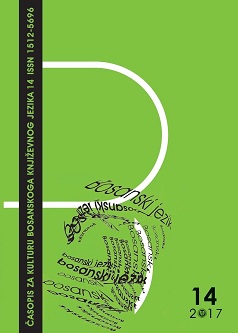Humina temporalna retroverzija: procesi (de)konstrukcije idilično-harmoničnog hronotopa u prozi Hamze Hume
Humo’s Temporal Retroversion: The Processes of (De)Consctructing the Idyllic-Harmonic Chronotope in Hamza Humo’s Prose
Author(s): Mirela Berbić-ImširovićSubject(s): Gender Studies, Novel, Bosnian Literature, Hermeneutics
Published by: Filozofski fakultet Univerziteta u Tuzli
Keywords: chronotope; myth; tradition; nostalgia; gender; subject;
Summary/Abstract: This paper primarily deals with Humo’s novel Grozdanin kikot from 1927, but with the aim of more complete scientific conclusions, it is supplemented by reading stories similar to Kikot, like Kaja (1926) and Priča o Jasiki (1927). However, since the idyllic-harmonic chronotope includes the one activated in the space of nature, as well as the one which is identified with the past, traditional ways of life (e.g. the tope of sevdah), thus the paradigmatic stories Sevdalijina ljubav (1925) and Krnata (1926) are included in the interpretation. The interpretation shall first critically consider the existing reading of the novel, which interpret it as a narrative of the final liberation of the subject from the anxiety of the historical space in order to integrate it into the nature as a new authentic chronotope of existence. However, our reading is based on demonstrating the unilateral stabilization of the subject: the stabilization which will problematically draw the line on the territory of gender unitarianism and supremacy. In order to demonstrate this polarization, one first has to redefine the chronotope of nature (Bahtin et al.), followed by the harmonically-idyllic mythical space and time, and the counterpoint (n)Nature / (c)Culture. The following question will be raised: Is Grlica’s suicide the confirmation of natural selection, which would, of course, correspond to the process of ‘naturalizing’ Kikot, or is it about subject interpelation and the ‘choice without choosing’, or in the end, about the place where paradoxically the subject is conceived!? Furthermore, in the context of the selected corpus by Humo, the question is raised about the adequacy of re-actualizing myth and tradition, and Humo’s temporal retroversion in the sense of subject abolition, who, having lost one locating space, thus the ‘traditional horizon of sense’ (Charles Taylor) has to search for a new one.
Journal: Bosanski jezik
- Issue Year: 2017
- Issue No: 14
- Page Range: 81-102
- Page Count: 22
- Language: Bosnian

